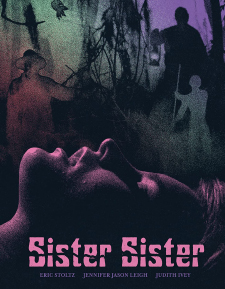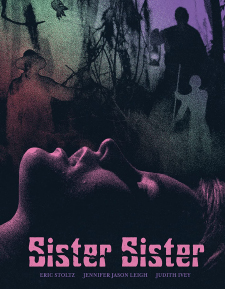Sister, Sister (1987) (Blu-ray Review)

Director
Bill CondonRelease Date(s)
1987 (March 29, 2022)Studio(s)
Oddessy Film Partners/New World Pictures (Vinegar Syndrome)- Film/Program Grade: B+
- Video Grade: B+
- Audio Grade: A-
- Extras Grade: A-
Review
Sister, Sister is a neglected Southern Gothic horror film from 1987 that marked the directorial debut of future Oscar winner Bill Condon. Condon co-wrote the script along with Ginny Cerrella and Joel Cohen, and while it blends a variety of genres from slasher to giallo, it’s definitely a Southern Gothic at heart. Lucy (Jennifer Jason Leigh) and Charlotte (Judith Ivey) are sisters living in an old plantation that they have turned into a boarding house. Charlotte is very protective of Lucy, who spent time in a mental institution, and so she tries to keep Lucy away from the affections of a young Cajun (Benjamin Mouton), while she struggles with her own relationship with the local sheriff (Dennis Lipscomb). When they take on a new boarder (Eric Stoltz), he threatens to drive a wedge between the two sisters, and reveal deadly secrets from the past that they have both been keeping buried.
There’s more than a touch of Hush...Hush, Sweet Charlotte in the proceedings, but Sister, Sister still finds a path of its own, with much more psychological horror, and even a whiff of the supernatural. The latter element is a bit muddled thanks to some post-production tinkering after an ill-fated test screening, which eliminated a coda that would have provided another layer to the story. Still, what’s left works reasonably well, with both Leigh and Ivey giving fine performances (though Stoltz seems a bit miscast). Unfortunately, New World Pictures had no idea what to do with Sister, Sister—as their marketing campaign clearly demonstrates—and the film failed to find an audience. It developed a minor cult following on home video, again without much help from New World, but it has always deserved more attention than it’s received to date.
Cinematographer Stephen M. Katz shot Sister, Sister on 35 mm film in the Super 35 format, using Panavision cameras with spherical lenses, framed at 2.35:1 for its theatrical release. This Blu-ray version uses a 2K scan of an interpositive, so it’s a bit softer than the original negative, and the grain is pretty coarse. On the other hand, Katz’s heavy use of smoke and other diffusion effects means that the image would be soft no matter what. Fortunately, as is typical of Vinegar Syndrome releases, the bit rate runs high enough to manage the grain without any real issues. The colors are generally muted, but again, that’s accurate with his intended look for the film. It may not be a dazzling transfer in relative terms to the best of what’s available on the format, but it’s a faithful one, and that’s the most important thing.
Audio is offered in English 2.0 DTS-HD Master Audio, with optional English subtitles. Sister, Sister was released theatrically in Ultra Stereo, so this is a four-channel mix matrixed into two. It's an aggressive mix, with the surrounds constantly carrying the ambient sounds of the bayou like birds, insects, frogs, running water, rain, and thunder. There are also many subjective surround effects, like the chiming of clocks surrounding the viewer at a key moment. The superb score by Richard Einhorn (Voices of Light) supports the oft-disconcerting imagery perfectly. The whole mix is a wonderful reminder that surround sound wasn’t just invented with the advent of 5.1; a good Ultra Stereo or Dolby Stereo mix like this one can still be remarkably effective today.
Vinegar Syndrome's Blu-ray release for Sister, Sister includes an insert with new artwork designed by Haunt Love on the front, and the original New World artwork on the reverse, as well as a 12-page booklet with an essay by Cristina Cacioppo. There’s also an embossed slipcover available directly from Vinegar Syndrome, limited to the first 5,000 units, that features the Haunt Love artwork. The following extras are included:
- Audio Commentary with Bill Condon
- Audio Commentary with Alexandra Heller-Nicholas
- Being an Outsider (HD – 13:50)
- Staying Honest (HD – 11:46)
- Orchestrating Altered States (HD – 24:52)
- Going to War (HD – 4:48)
- Deleted Scenes (Upscaled HD – 3:03)
- Original Trailer (HD – 1:49)
The commentary with Bill Condon was originally recorded for the 2001 Anchor Bay DVD release, and Condon notes that it was the first time that the film had been seen in widescreen on home video—even the LaserDiscs were panned and scanned. (He points out various shots that made no sense in the cropped version.) He explains how he came to be involved with the film, and how disastrous test screenings resulted in changes, but it was still a critical and commercial failure. As a result, he spent the next several years in “movie jail,” directing made-for-cable movies. He’s pretty open about the fact that he wishes that he had done many things differently in Sister, Sister, and that the ending doesn’t work the way that he intended since a bookend scene was removed after the test screenings. He provides interesting trivia about the film as well, such as how he nearly cast Johnny Depp in a small part, and the fact that the mechanical alligator in an early scene had been borrowed from Lewis Teague’s Alligator.
The new commentary is with author and critic Alexandra Heller-Nicholas, who notes that Sister, Sister is a film with so much going on beneath its seemingly simple surface. She spends time analyzing the genres involved, from Southern Gothic to North American giallo, and says that it also has a fairy tale quality. She dives into the mirror imagery and water imagery that permeates the film, noting how it’s interested in distorted realities and fractured identities. Ultimately, she feels that rape trauma lies at the heart of the film. She gives some technical information as well, like describing the cinematography and the shooting locations, but she’s far more interested in the themes that are involved. As a result, the two commentary tracks work well together, with little of the duplications that often occurs when there are multiple tracks. (The only oddity with this one is that there are a small handful of lengthy gaps that almost sound like some material was removed by an overzealous legal department.)
Being an Outsider is an interview with Benjamin Morton, who reminisces about his path to becoming an actor (Sister, Sister was his first film.) Amusingly, he explains that while he’s a real Cajun, he’s never had an accent, so he struggled the most with faking one. Staying Honest is an interview with actress Natalija Nogulich, who talks about the research that she did for the film, and how she tries to build a life for the characters that she plays. For some reason, the footage of her speaking appears washed out here, and it’s the footage itself since the clips that are intercut look normal. Orchestrating Altered States is an interview with composer Richard Einhorn, who traces his career starting with his first film Shock Waves before talking about Sister, Sister. He explains how he mashed up both Dvorak’s Symphony No. 9 and Schubert’s Symphony No. 8 to create the main theme, and that he didn’t want the strings to sound like strings, so he surrounded them with electronic swells to create a mysterious altered state of sound. Einhorn is a lively interview subject, so this is one of the most enjoyable extras on the disc. Going to War is an interview with cinematographer Stephen Katz, who discusses his working relationship with Condon. He describes how he shot the film, including the low-key lighting and his heavy use of smoke. He also used one stock for the entire film, interiors and exteriors alike, because he liked the look of that particular stock and also for simplicity’s sake. Interestingly, he says that his touchstone for the color scheme in Sister, Sister was Bertolucci’s The Conformist.
The Deleted Scenes can be played with or without optional commentary by Condon. It’s just a few short clips, but they give a glimpse at how his original design for the first twenty minutes of the film changed after the unsuccessful preview. The bookend scene at the end that Condon refers to in his commentary track isn’t included here.
Despite the fact that the failure of Sister, Sister set back Bill Condon’s career, he had the last laugh eleven years later when he took home a well-deserved Oscar for his screenplay for Gods and Monsters. (Condon’s love for James Whale is evident in Sister, Sister, where one character wears a familiar-looking wig.) So it all worked out in the end, even if Sister, Sister is still in search of an audience. Hopefully Vinegar Syndrome’s well-rounded Blu-ray package finds its way into the hands of some potential new fans for the film.
- Stephen Bjork
(You can follow Stephen on social media at these links: Twitter and Facebook.)

